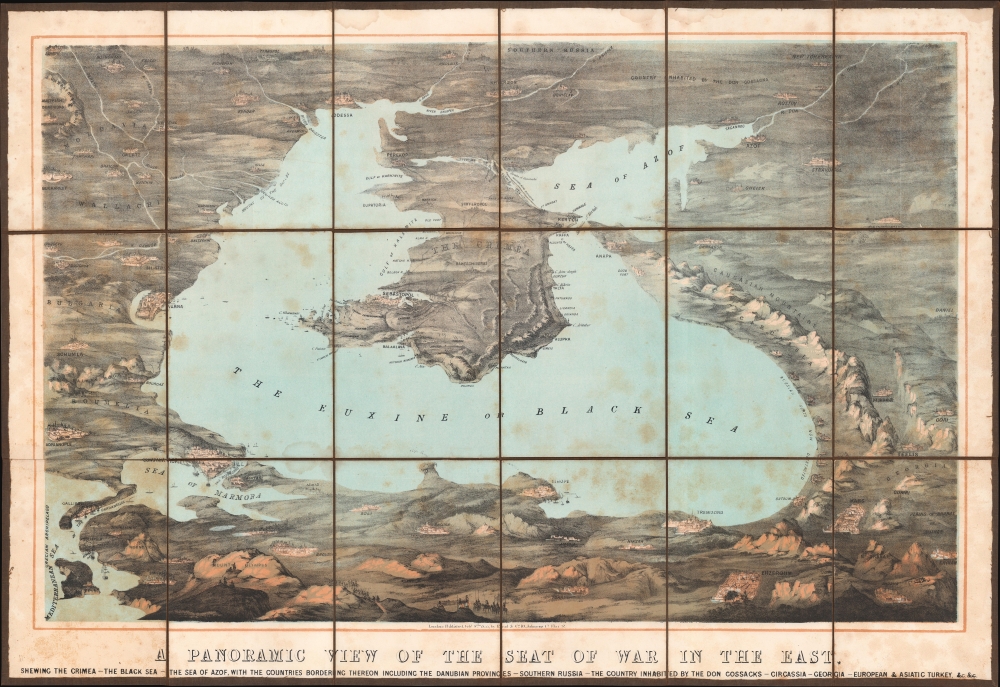This item has been sold, but you can get on the Waitlist to be notified if another example becomes available, or purchase a digital scan.
1855 Read Bird's-Eye View of the Black Sea and Crimea During the Crimean War
CrimeaBlackSea-read-1855
Title
1855 (dated) 19 x 27.5 in (48.26 x 69.85 cm)
Description
A Closer Look
This view is strikingly formatted with Crimea - the focal point of the conflict - greatly exaggerated. This strategic dysmorphia allows read to expand the scope of of the view to include the entire theater of war: the Black Sea, the Dardanelles , the Sea of Marmara (Marmora), and the Bosporus (Bosphorus), as well as the surrounding parts of Europe, Russia, the Caucuses, and Ottoman Empire. Warships appear on the Black Sea outside Sevastopol (Sebastopol), off Cape Khersonesc, and near Varna. French and English entrenchments are marked to the south of Sevastopol.The Crimean War
The Crimean War, with an alliance of the Ottoman Empire, Britain, France, and Sardinia on one side of the conflict and the Russian Empire on the other, lasted from October 1853 until February 1856. The root cause of the war has never been fully understood, but the stated impetus for hostilities was the rights of Christians in the Holy Land, with the Catholics being supported by the French and the Greek Orthodox Church gaining the support of the Russians. Other factors also included the gradual decline of the Ottoman Empire and British and French concerns about Russian gains in the region at the cost of the Ottomans.Hostilities erupted in July 1853 when Russia invaded two Ottoman suzerainties known collectively as the Danubian Principalities: Wallachia and Moldavia. The Ottomans immediately responded and fought a defensive campaign that eventually halted the Russian advance at Silistra, which the Russians besieged. Alarmed by the possibility of an Ottoman collapse, the British and French jumped to their aid, sending troops and supplies to Gallipoli. They did not arrive at Silistra until after the Russians had withdrawn.
At this point, public opinion at home, general discontent aroused by the wasted effort and expense of sending armies to the Balkans, exerted an influence on the alliance. This outcry led to the planning and execution of an invasion of the Crimean Peninsula and a siege of the Russian naval port of Sevastopol, their primary naval base in the Black Sea. The siege lasted eleven months. Russia finally sued for peace in March 1856. In the Treaty of Paris that ended the war Russia lost its Black Sea ports, Wallachia and Moldavia gained a modicum of independence, and Christians in the Holy Land were given a degree of equality.
Chromolithography
Chromolithography, sometimes called oleography, is a color lithographic technique developed in the mid-19th century. The process involved using multiple lithographic stones, one for each color, to yield a rich composite effect. Oftentimes, the process would start with a black basecoat upon which subsequent colors were layered. Some chromolithographs used 30 or more separate lithographic stones to achieve the desired product. Chromolithograph color could also be effectively blended for even more dramatic results. The process became extremely popular in the late 19th and early 20th centuries when it emerged as the dominant method of color printing. The vivid color chromolithography produced made it exceptionally effective for advertising and propaganda imagery.Publication History and Census
This view was created and published by Read and Company in 1855. It is not cataloged in OCLC, and we note only two instances when it has appeared on the private market.Cartographer
Mary Read (fl. c. 1850 – 1865) was a British lithographer and publisher of illustrated children's books, general interest books, prints, and views active in London during the middle part of the 19th century. Read had the distinction of being one of the few independent female publisher's active in the 19th century. To our knowledge she issued by three birds-eye views and no maps. These include two views of India, and one of the eastern part of the United States during the Civil War. Little else is know of the woman or the firm. Her firm was based at 10 Johnson Court, Fleet Street, London. More by this mapmaker...

